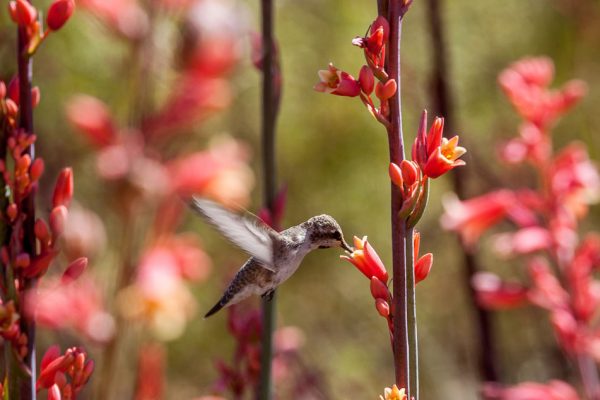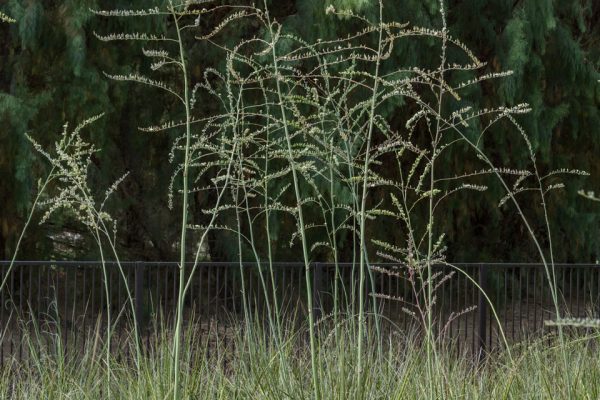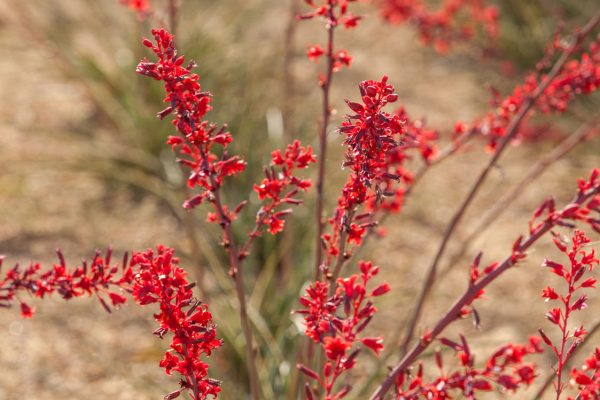
Our medium-sized Hesperaloe is the extremely popular parviflora species, called Red Yucca or Hesperaloe. Due to its easily managed size and beautiful flowers, it is one of the most common Hesperaloes you will see in public garden spaces. Growing up to 4 feet, it develops curving marginal filaments that pull away from the leaf edge, giving the appearance of coarse hair growing off the edges. This makes it easy to distinguish from other rosette-forming succulents.
Red Hesperaloe grows a flowering stalk called a raceme. It can grow to a height of 9 feet, though at Sunnylands it grows normally between 6 and 7 feet, much lower than the 16 foot raceme of its cousin Giant Hesperaloe. Its blooms vary in color through natural garden cross-pollination and human cultivation, but they tend to stay in the dark red to coral pink ranges. This species is a parent of the smaller Hesperaloe called Brakelights, also planted at Sunnylands.
Hesperaloe in general appears to be popular with not only nectaring hummingbirds but also with opportunistic Monarch and Queen Butterfly caterpillars. When Hesperaloe is placed near milkweed beds, chrysalis of both butterflies have been found attached to its leaves. But chrysalis also has been found on agaves, so this is not an identifying feature.

The Giant Hesperaloe is the largest species of the genus Hesperaloe. This giant grows a rosette of crescent-like leaves that reach 6-feet high. For those not familiar with the differing desert genera that grow in a similar style, it can be difficult to distinguish them when not in bloom. Hesperaloe has one helpful indicator for identification, no this pattern is not exclusive to this genus, it helps identify it in these gardens. It is curving marginal filaments that pull away from the leaf edge, giving the appearance of coarse, white hair growing off the edges. If you see those, you then need to determine which species of Hesperaloe you are seeing in the gardens, which is easy. You simply determine, if it is in the 6 foot leaf range and if it is, you are probably looking at the Giant as there are only three species in the gardens, and they fall into the large, medium, and small categories.
Hesperaloe can expand by clumping additional tiny rosettes around the parent plant, as well as setting seed through flowering. They also readily cross-pollinate and hybridize. Giant Hesperaloe displays both pink and white blooming varieties, which grow on a flowering stalk called a raceme. The raceme can reach up to 16 feet. The creamy-white flower is associated with the original funifera species, but the other is a pinkish-toned hybrid. These are both pollinator favorites.
Hesperaloe in general appears to be popular with not only nectaring hummingbirds but also with opportunistic Monarch and Queen Butterfly caterpillars. When Hesperaloe is placed near milkweed beds, chrysalis of both butterflies have been found attached to its leaves. But chrysalis also has been found on agaves, so this is not an identifying feature.

Brakelights is the smallest of the Hesperaloe species at Sunnylands. The term [perpa] in its name means it is a copyrighted variety created through intentional cultivation. From this name, you can probably guess that it was cultivated to accentuate the deepest red variations that have occurred in the parviflora species.
Brakelights has a longer bloom period than its parviflora parent, which is possible because it does not set seed. The additional energy not used in the seed-setting processes allows it to extend its season. It blooms a deep red, but can be tinged with dark purple, making it incredibly striking to see in contrast to the lighter coral and cream blooms of its parent.
Hesperaloe in general appears to be popular with not only nectaring hummingbirds but also with opportunistic Monarch and Queen Butterfly caterpillars. When Hesperaloe is placed near milkweed beds, chrysalis of both butterflies have been found attached to its leaves. But chrysalis also has been found on agaves, so this is not an identifying feature.


